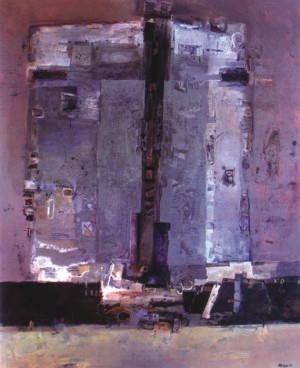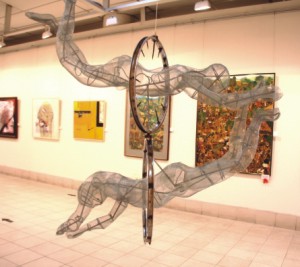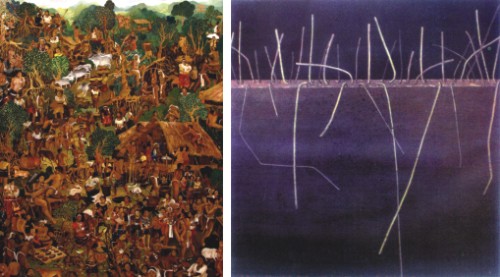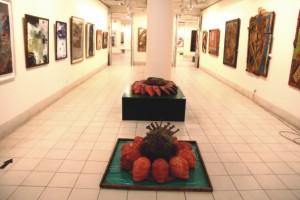|
Exhibition
National Art Exhibition
Ershad Kamol
 |
| Fragmented Image-3, Golam Faruque Bebul. |
National art exhibition organised by the Department of Fine Arts of Bangladesh Shilpakala Academy has played a significant role to promote the artists nationally. To participate in the exhibition the artists get busy prior to the exhibition to present something outstanding to achieve the awards. Even a chance to participate at the exhibition is encouraging for many artists. And, of course, it creates the opportunity for art lovers to have an idea of the trends in contemporary art.
Initially, there was no competition section in the national exhibition when it was introduced in 1970s. In those days the academy honoured one senior artist at the national exhibition as of recognition of his contribution to art. Subsequently, the exhibition became so popular that the academy had to introduce a selection committee to select the art works for display at the exhibition. In response to the demand of the artists, a jury had been formed to select the winner of the awards. To give more colour to the arrangement, a few private organisations and persons donated funds to introduce more awards to encourage the artists.
But for the last few years the national art exhibition has been losing its grandeur. Many well-reputed artists are not participating. Even the number of viewers has decreased significantly, despite the infra-structural development of the academy.
 |
| Bangladesh Shilpakala Academy award winning art work, Target-2 by Mohammad Mahmudul Hasan |
For instance, the number of participating artists has decreased at the ongoing 18th National Art Exhibition at the National Art Gallery. When 373 artworks by 247 artists were on display at the last arrangement, this year 222 art works by 198 artists are participating at the exhibition. While the exhibition used to continue for a month, this time it has been organised as a fortnightly exhibition.
Moreover, only in this year the display of contemporary works by the seasoned artists has been excluded, though usually, 10 seasoned artists used to be invited to participate at the exhibition in addition to the competition section.
Let alone the common people, even many artists and art critics have not gone to Shilpakala Academy so far to watch the exhibition, though it was inaugurated on May 24. However BSA officials blame the lack of coverage by the mass media for less publicity of the national exhibition.
Deputy Director of the Department of Fine Arts of the academy claimed that like the previous arrangements Shilpakala invited art works from the artists by sending letters by name and giving advertisements in the newspapers. "Out of 1800 art works submitted by 600 artists, a five-member selection committee has selected 222 art works of different artists for the exhibition," informs the Deputy Director informs.
"Another five-member jury including the leading artists of the country such as Aminul Islam, Quayyum Chowdhury, Mostafa Monwar, Rafiqunnabi and Abul Mansur, selected 10 awards winners. All of the participants are regular artists. And most of the seniors in these days do not work regularly. Which is why they do not participate", he adds.
 |
| L-R: Moorang-2, Musrat Reazi and Beginning of Complexity-8, Anisuzzaman |
For his innovative sculpture titled Target 2 Mohammad Mahmudul Islam won the Bangladesh Shilapakala Academy Award. Musrat Reazi won the AB Bank Award for Moorang 2, Golam Faruque Bebul won the Bengal Foundation Award for Fragmented Image 3, Bishwajit Goswami won the Bhasha Shainik Gaziul Haque Award for Self Portrait 1, Abdus Salam won the Begum Azizunnesa Fine Arts Award for Rejection 09/B, Syed Fida Hossain won the Dipa Hoq Award for Philosopher of Changing Wind 1. Moreover, Mahbubur Rahman, Nagarbashi Barman and Anisuzzaman won Honourable Mention for When My Brain Was Blind, Broken Boat 4 and Beginning of Complexity 8 respectively. Special features of this years' arrangement includes the experimentation done by the artists, most whom belong to 25-35 age limit, in terms of use of medium and composition. For instance, all of the prize winning art works are highly experimental and deserve plaudits.
Two figures of Mohammad Mahmudul Islam's sculpture Target 2 features the ever going struggle of human beings to reach the goal overcoming the hurdles created by socio-political turmoil. The medium is also innovative: the artist has used transparent aluminum fibre to create the form of human figures.
"It's really an innovative work", says eminent artist Rafiqunnabi, a member of the five-member jury of the exhibition, "In fact, the sculpture sector has significantly improved in Bangladesh compared to other media."
 |
| Rejection 09/B, Abdus Salam |
"Most of the participants at the exhibition are young artists and have 'over experimented' without having proper knowledge on the media. Following the global trends, most of them have come up with new media such as installation and video art. However, to me they have not yet adopted well with such media, since they don't get much scope to practice these media except participating at the competitions. As a result conceptually they are not clear when they address the society through such media which is what the foreign artists do. With a few exceptions, most of the paintings are of average standard. And only those exceptional works have won the awards", he evaluates.
According to Rafiqunnabi, competitions. Except this year, Bangladesh Shilpakala Academy used to invite ten selected artists from our generation to display their contemporary works at the exhibition. But, for some unknown reasons this year the academy has not invited us. And the renowned artists of our next generation have little interest, since they have already achieved reputation at the national and international arena. Which is why, perhaps, they are giving floor to the younger artists."
 |
| Most of the 222 art works on display are highly experimental. |
lack of interest of the senior artists and participation of hundreds of young artists at the national exhibition is quite natural. He says, "Seasoned artists of my generation have never participated at the competitions. Except this year, Bangladesh Shilpakala Academy used to invite ten selected artists from our generation to display their contemporary works at the exhibition. But, for some unknown reasons this year the academy has not invited us. And the renowned artists of our next generation have little interest, since they have already achieved reputation at the national and international arena. Which is why, perhaps, they are giving floor to the younger artists."
However, renowned artist Shishir Bhattacharya blames mismanagement and lack of leadership at the Department of Fine Arts of Bangladesh Sahilpakala Academy as the reasons behind reluctance of the senior artists to participate at the national exhibition.
"Undoubtedly both of national art exhibition and young artists' exhibition, organised by the academy, have played a very important role for development of art trends in Bangladesh", continues Shishir Bhattacharya, But for the last few years these exhibitions and competitions have lost their grandeur. And it's because of inactiveness and inefficiency of the officials of the government agency."
 |
When my brain was blind, Mahbubur Rahman |
In fact, for the last few years the Department of Fine Arts of the academy had been run by either civil bureaucrats or officials of the academy who had never any connection with the art circuit. As a result, many artists have lost their interest in this event.
When the Director General (DG) of Bangladesh Shilpakala Academy Kamal Lohani was contacted for his comment on the issue he admitted the problems. "I believe a professional well connected with the art circuit should be at the helm for a technical department like fine arts. We've already addressed the issue in the ministry."
Commenting on the ongoing exhibition the DG says that it could be organised more coloufully by installing banners festoons and other decorations to attract the visitors.
Kamal Lohani says that the academy these days is highly dependent on ministry decisions, despite it being an autonomous body. "Lack of funds is another major problem for organising quality programmes", he says.
However, the DG is optimistic. It is expected that reflecting his optimism the academy does something meaningful for the cultural development of the country, which is at present becoming a little stagnant.
Copyright
(R) thedailystar.net 2009 |
